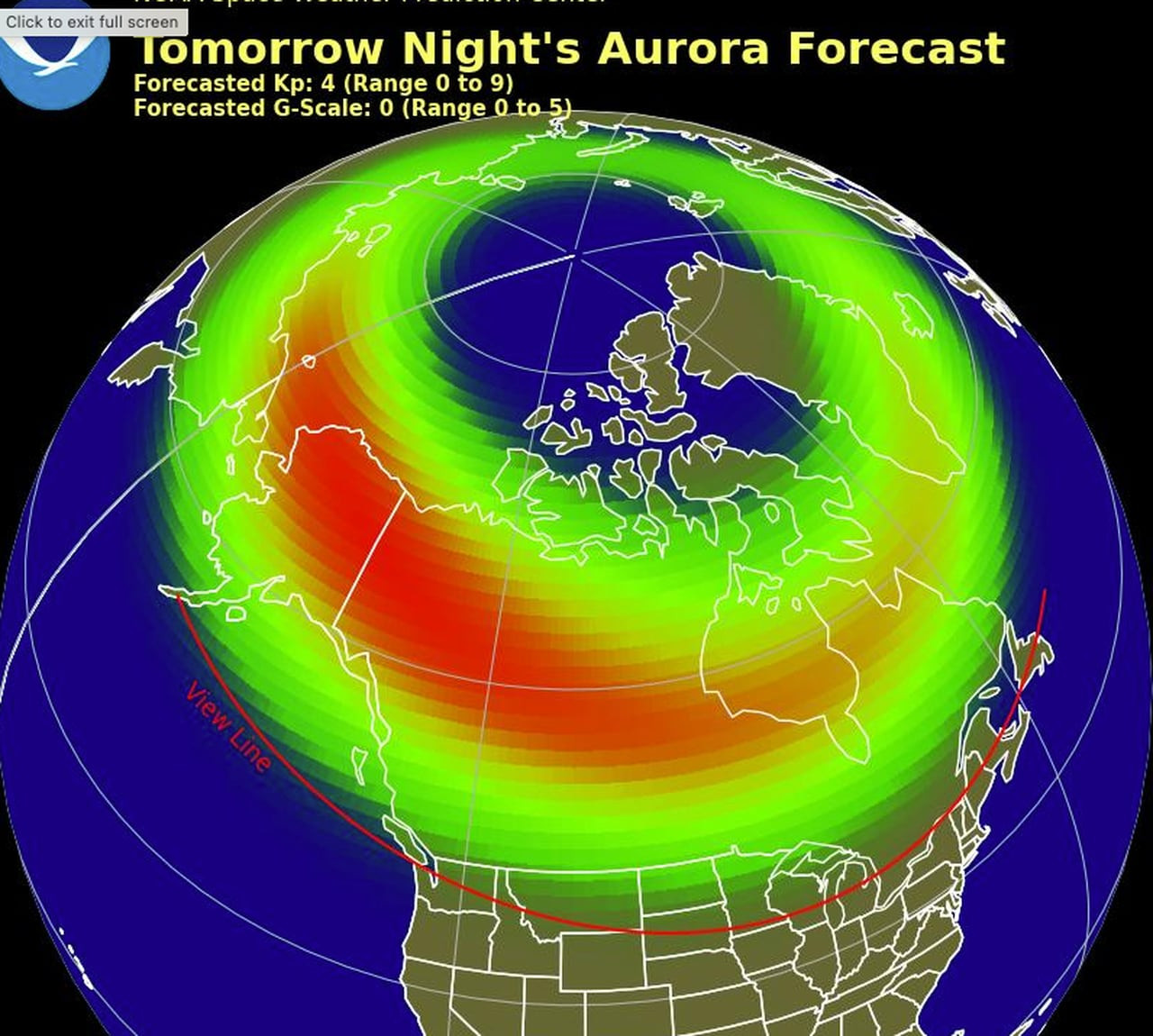A number of states across the northern U.S. may be able to see the northern lights Sunday night into Monday morning as a geomagnetic storm rolls in, according to a forecast from the National Oceanic and Atmospheric Administration. (UPDATE: Check out Monday’s forecast here.)
The aurora borealis forecast for Sunday night has a Kp index of seven on a scale of nine, meaning the aurora will become “quite bright and active” and may be able to be seen from the northern edge of the U.S., according to NOAA. The northern lights may be visible as far south as Pennsylvania, Iowa and Oregon because of a strong geomagnetic storm rolling in Sunday night.
Monday’s preliminary forecast has a Kp index of five—which can make the aurora bright and active enough that it “can be quite pleasant to look at”—meaning it will likely be visible to fewer places than Sunday, but still possible to see.
How Northern Lights Form
The appearance of the northern lights come from geomagnetic activity, which can lead to the collision of ions with atmospheric gasses from Earth and create auroral displays, and NOAA is predicting a strong geomagnetic storm Sunday into Monday due to the eruption of solar material.
Tips for Seeing the Northern Lights
The northern lights are best seen in dark locations away from city lights between 10 p.m. and 2 a.m. local time. It’s best to have a good vantage point with an unobstructed view looking north.
The Science Behind the Northern Lights
The aurora borealis has been more visible in recent months because of the solar cycle the sun is in that it goes through every 11 years or so, and NASA predicted the frequent sightings will continue into next year. Solar activity has been busy in recent months as the sun approaches the peak of the cycle, which is expected between late 2024 and early 2026. Sunspots are expected to intensify over the next year, which could trigger more geomagnetic storms and viewing opportunities for the northern lights in the U.S., though it is difficult to predict when storms will occur.
Northern Lights in the UK
The northern lights, also known as aurora borealis, appear when charged particles collide with the gases of the Earth’s atmosphere around the magnetic poles. This collision emits light of various wavelengths, spilling colour across the skies. The particles usually come from solar flares – explosions on the sun – or solar gas ejections.
Different colours are produced depending on the gas being energised by the charged particles. Nitrogen – earth’s most abundant gas – emits purple, blue and pink light, whilst oxygen produces green.
The lights may illuminate the sky over parts of the UK on Monday night and early Tuesday morning, the Met Office has said. The lights, also known as aurora borealis, are most likely to be visible in areas of clear sky including in Scotland and Northern Ireland as well as northern parts of England and Wales, the forecaster said. There may also be a “chance of sightings further south”, the Met Office added in a post on X.
For those hoping to spot the aurora, meteorologists have advised staying away from areas with light pollution and using a long exposure camera as they are better able to adapt to different wavelengths than the naked eye.
Met Office spokesperson Andrea Bishop said: “Aurora activity is expected to peak on Monday following the forecast arrival of a coronal mass ejection. However, for the UK, this period is expected to coincide with daylight hours. Lingering effects are still likely to persist into Monday night and early Tuesday morning though, meaning that aurora is likely to be visible where skies are clear from Scotland and Northern Ireland, as well as parts of England and Wales, mainly in the north. It’s not possible to predict how far south the coronal mass ejection may be seen or pick out cities, but in terms of visibility overnight, there are generally clear skies for most tonight, however, it will be cloudier across the Northern Isles and western Scotland, with patchy rain and drizzle as well as cloudier skies in Northern Ireland. There’s also patchy cloud for some in the South East and East Anglia.”
Remote, open areas with views of the northern horizon are best for sightings, with the lights unlikely to be visible until it gets very dark.
Aurora displays occur when charged particles collide with gases in the Earth’s atmosphere around the magnetic poles. As they collide, light is emitted at various wavelengths, creating colourful displays in the sky. In the northern hemisphere, most of this activity takes place within a band known as the aurora oval, covering latitudes between 60 and 75 degrees. When activity is strong, this expands to cover a greater area – which explains why displays can be occasionally seen as far south as the UK.
More Aurora Sightings Expected
The Met Office says there will be another chance to see the lights on Friday night into Saturday. Stargazers have been sharing stunning images of the Northern Lights that were visible across parts of the UK on Thursday night. The lights, also known as aurora borealis, could be spotted into the early hours of Friday morning.
More Opportunities to See the Northern Lights
Krista Hammond, a space weather forecaster at the Met Office, said in May: “The sun has a roughly 11-year cycle of activity, and this is from what’s known as solar minimum, which then goes towards solar maximum, and back to solar minimum. And we’re now approaching the solar maximum.”
The Solar Cycle and Northern Lights
Aurora are generally becoming more frequent as we enter solar maximum – the period of peak solar activity during the sun's 11-year solar cycle. The solar cycle is the cycle that the sun's magnetic field goes through about every 11 years, before it completely flips and the sun's north and south poles switch places. Scientists can track the solar cycle is by counting the number of 'sunspots' – dark areas on the sun's surface – and when exactly they appear, mostly using satellites. The beginning of an 11-year solar cycle, when the sun has the fewest sunspots, is known as the solar minimum – but over time the number of sunspots increases as it reaches solar maximum. A recent study predicted the solar maximum is coming sooner than expected – 2024 rather than late 2025 – meaning space weather will be most pronounced. 'The most intense storms can sometimes result in catastrophic orbital decay of low Earth orbiting satellites and disrupt satellite based services such as communications and navigational networks,' study author Dr Dibyendu Nandi, a physicist from the IISER Kolkata Center of Excellence in Space Sciences in India, told MailOnline. 'They can also induce strong disturbances in the geomagnetic field tripping electric power grids located in high latitude regions. Of course, they also create beautiful auroras so we can expect 2024 to be a good year for aurora hunters.'
The Aurora Explained
Tonight's aurora stems from a coronal mass ejection (CME) – a massive expulsion of plasma from the sun's corona, its outermost layer, which left the sun on Saturday. The high-energy particles travelled from the sun towards us at hundreds of miles per second before bombarding Earth's magnetosphere – an event commonly known as a 'solar storm'. At this point, some of the energy and small particles can travel down the magnetic field lines at the north and south poles into our planet's atmosphere. There, the particles interact with gases in our atmosphere, resulting in beautiful displays of light in the sky, known as auroras. Oxygen gives off green and red light, while nitrogen glows blue and purple. Although not dangerous to humans, the particles aurora can damage power grids on Earth and satellites in orbit, which can lead to internet disruptions.
The Best Places to See the Northern Lights in the UK
Some of the best aurora spots around the UK are in areas of high elevation (closer to the magnetosphere) and away from cities that pollute the sky with artificial light. These aurora hotspots include the Lake District in Cumbria, Arthur's Seat in Edinburgh, the Shetland Islands and Whitley Bay, North Tyneside.
A Spectacle Worth Witnessing
The Northern Lights are a breathtaking natural wonder. So if you have the opportunity to see them, don't miss out! They are a truly awe-inspiring sight that will leave you breathless.

















